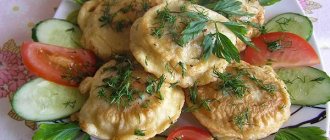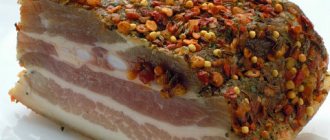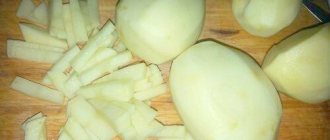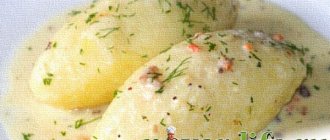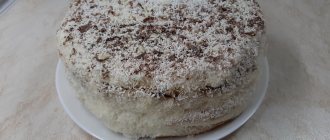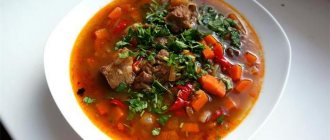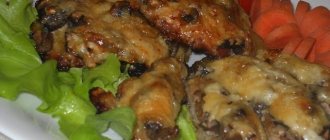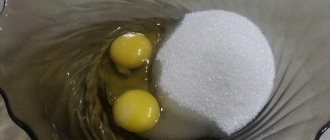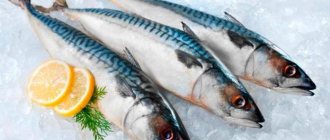Pressed pork head meat
Pressed pork head meat is a satisfying, tasty and quite simple dish, although it takes a long time to prepare.
In some ways, this meat is similar to brawn , but denser, so it can be used for sandwiches and as a slice for the holiday table. Keeps its shape well and does not fall apart.
If you have a ham maker , then you can press it in it.
It is best to serve pressed pork head with mustard, horseradish, onion, garlic and black bread. Well, it’s clear what drinks to go with, especially since the dish is fatty and as an appetizer it’s beyond praise.
Ingredients:
- Pig head. ½ pcs. (≈4 kg) Here the meat is removed from the bones in advance, but this is not necessary.
- Onion. 1 PC.
- Garlic. 3-4 heads. (≈20 cloves).
- Bay leaf. 3-4 pcs.
- Black peppercorns. 1 teaspoon.
- Salt. Taste.
Cooking:
Chop the pork head into pieces so that they fit in the pan. I did it differently, I removed all the meat from the bones in advance and at the same time cleaned the skin with a knife. Fill with cold water and leave to soak for about 8-12 hours. We change the water 3-4 times.
We thoroughly wash the soaked meat again, scrape the skin with a knife and place it in a pan. Fill with cold water so that it covers the meat by 3-4 fingers and place on high heat. If there is a tongue, then we use it to prepare the dish.
Bring to a boil and carefully skim off the foam.
We reduce the heat to minimum so that the boil is very low - the water just stirs slightly, but does not boil intensely.
Simmer over very low heat for at least 2½-3 hours, preferably 5-6 hours. An hour before the end of cooking, add black peppercorns and onions to the pan, and after another half an hour, add salt to taste and bay leaves.
Peel and finely chop the garlic. It is convenient to use a chopper for this, but you can also just use a knife. Pork goes very well with garlic, so this dish should have a lot of garlic.
Turn off the heat under the pan. Remove the boiled meat from the broth and let it cool slightly. If you also used a tongue, then immediately place it in cold water for 5 minutes so that you can easily remove the skin from it. We throw out the onion and bay leaf - they are no longer needed.
When the meat is ready and cooled, remove it from the bones and cut it into small pieces together with the tongue. You can first carefully remove the pork skin, which will form the outer layer of the finished dish. Or you don’t have to bother with this process and cut everything together. You need to try to cut it, and not just mash the meat with a fork or stretch it into fibers.
Transfer to a bowl and add garlic to the bowl.
Mix everything very thoroughly, taste and, if necessary, adjust with salt and pepper.
Line the colander with several layers of gauze. At the same time, we make a “podium” for it - you can simply put an inverted saucer in a wide saucepan. I have a small colander from a kids toy set so I use that.
Place the meat and garlic tightly in a colander and place it on the prepared “podium”. For beauty, you can first line the gauze with large pieces of overlapping pork skin, if you removed it from the boiled meat in advance, and then place the pieces of meat on the skin.
Cover the meat with gauze and place an inverted small plate on top of the gauze so that it fits freely into the colander at least a quarter of the way.
We place a weight on a plate - 2-3 kilograms.
Leave the meat for 5-6 hours at room temperature to remove excess liquid. Then you can put the pressed meat in the refrigerator for at least another 3 hours, and preferably overnight.
In the morning we remove the oppression and unroll the gauze.
Cover the colander with a dish or large plate and turn the entire structure over. Carefully remove the colander and then the gauze.
That's it, the pressed pork head meat is completely ready. Can be cut into pieces and served. This meat holds its shape well, even when cut into fairly thin slices, and looks very impressive on the table.
Served with black bread, mustard, horseradish, garlic and onions and/or green onions.
Everything ingenious is simple
Recently, the daily menu of any family is increasingly being “attacked” by sausages.
They have become a real attribute for a quick breakfast or light dinner. This significantly reduces cooking time, but does not provide the same pleasure that is felt after eating food prepared with your own hands. And it’s not that difficult to do. Take, for example, a pig's head. You can make not only jelly from it, but also something interesting. There is an excellent recipe that makes it easy to make unusual pressed meat from a pig's head. For this you will need a pork head, garlic, onions, ground pepper, carrots, spices and water. You need to prepare as follows:
- Wash the pork head, cut it into two parts lengthwise and place in a wide pan.
- Pour the product with water and immediately cook for 4 hours.
- After this, remove both halves from the pan, place them on the table and completely remove them from the bones.
- Then spread gauze on the table, place one piece on it, skin side down, and generously season it with spices.
- Roughly chop onion, carrots and garlic. Mix the products and spread the resulting mass on top of the first piece of head.
- Cover the entire structure with a second piece and wrap the resulting roll very tightly in gauze.
- Place pressure on top and leave the product in this position for one day.
Pressed pork head meat prepared in this way turns out very tasty, juicy and aromatic.
How to choose the right one
Pork's head is a product that does not stay on the market for a long time. The low price and the ability to prepare several delicious dishes attracts knowledgeable buyers.
It is better to make a purchase at the market in the morning. After studying a few simple rules and using them in practice, choosing a quality product will not be difficult.
Attention! In the old days, pig's head was served in every tavern and dishes from it were highly expensive.
- The head, which has been tarred with straw, has a yellowish tint. If it was a pig - cream color. In the case of processing with a blowtorch without straw, the burnt residue does not appear on the finger. The untarred head is covered with white skin. This product was most likely deep frozen.
- Before you give money to the seller, you should smell the future purchase. A properly prepared head emits a pleasant aroma of tarred meat. Any foreign smell will indicate improper storage of the workpiece.
- No mucus or moisture should be felt on the product. If the technology is followed, the head may be covered with faint blood droplets at the site of separation from the carcass.
- If meat is purchased at the market, a laboratory testing stamp is required.
Attention! A whole pig's head goes rotten quickly. To prevent such a problem from happening, you need to cut it up immediately after purchase.
Proper preparation
Before cooking a pig's head, it must be properly gutted. First of all, if you get stubble, shave it off with the cheapest disposable razor. We don’t recommend scorching - you won’t like the smell and it will take a long time to dissipate. Then take a hard brush or washcloth in your hands and scrub the skin in all places, paying special attention to hard-to-reach areas - the snout and ears. Further cutting depends on what you are going to cook from the pork head: in some recipes you need it whole, in some - in pieces or only its meat parts. But the basis remains the same: the offal must be washed very carefully!
Pork head baked in the oven
My aunt told me how to cook a pork head baked in the oven a long time ago. She was always very good at it. Now I can boast of the same!
Ingredients:
- Pork head - 1 piece (weighing approximately 3.5-4 kg)
- Salt - 2 teaspoons (or more to taste)
- Shallots – 6 pieces
- Garlic – 2 pieces (heads)
- White wine - 2 glasses (dry)
- Brandy - 0.5 glasses
- Dijon mustard - 1/2 teaspoon
- Water – 2 Liters
- Pepper - 1 teaspoon (or to taste)
- Parsley - 6 pieces (sprigs)
- Thyme – 6 pieces (sprigs)
- Bay leaf – 3 pieces
Number of servings: 10
How to cook “Pork head baked in the oven”
1. Rinse your hair thoroughly. Dry it with paper towels, clean inside and outside. 2. Heat the oven to 150 C. Place the head in a deep oven-safe container (frying pan, saucepan). Rub it with salt and pepper, place peeled onions, garlic cloves (unpeeled), and herbs next to it. Pour in water and alcohol. The liquid should cover the head about halfway. Wrap your ears in foil (otherwise they will burn). Cover the baking sheet head with foil. 3. Place the pan on the stove and bring the liquid to a boil. After that, put it in the oven. It should stay there for about 2 hours. Then remove the foil (but leave it on the ears) and continue cooking until most of the liquid has evaporated, the skin is browned and the meat pulls easily from the bone (this will take about 4 hours). If the ears are still soft, you can remove the foil from them and hold them for another 20 minutes. 4. Before serving, let the pork “rest”, covering it with foil for about 15 minutes. Pour the remaining juice (without herbs and vegetables into a small saucepan. Cook until thickened, remove fat, add mustard and serve pork with sauce.
Nutritional and energy value:
| Ready meals | |||
| kcal 10219.8 kcal | proteins 9 g | fat 0.7 g | carbohydrates 46.7 g |
| Portions | |||
| kcal 2555 kcal | proteins 2.3 g | fat 0.2 g | carbohydrates 11.7 g |
| 100 g dish | |||
| kcal 191 kcal | proteins 0.2 g | fat 0 g | carbohydrates 0.9 g |
Pressed meat
For it, take a pork head (photo in the article), wash it thoroughly and boil it for a long time - about five hours. Towards the end of cooking, spices and salt are added. You can limit yourself to laurel and pepper, or you can choose something to suit your taste. Then the head is disassembled; soft cartilages also come into play, as does lard, which needs to be cut into smaller pieces. All the cuttings are mixed with garlic, placed in a colander (it is better to line it with gauze), poured with a glass or two of broth and placed under pressure in the refrigerator. After about five hours the meat can be consumed.
How to cut
Delicious dishes are obtained when the head is properly cut. Therefore, you need to be patient and do the work in accordance with the following points:
- Carefully scrape off the smoke from the ears and other places.
- Using a well-sharpened knife with a strong blade, the ears are separated. Do this as close to the main part as possible.
- Start separating the cheek. Using a large knife, the meat along with the skin is cut from the top of the head to the snout. At this point you should be very careful and try not to touch the eye socket. If the dark liquid fills the organ of vision, if it gets on the separated piece, it will spoil its appearance.
- The frontal part is cut off. They do this with a knife point-blank.
- The chin is treated. They take out the tongue.
- Using a sharp ax or cleaver, you need to cut the skull, after which the head is divided into 2 parts.
- Separate the lower and upper jaws by running a knife along the connecting ligament.
- Cut off the patch.
- They begin to separate the jaws.
The remaining bones with meat are sent for storage and later used for cooking broths. The cutting is completed by removing the eyes and brain. The first ones are sent to feed animals. The head, cut according to all the rules, is soaked in cold water for at least 6 hours.
Advice. If you are not confident in the success of cutting yourself, it is better to ask professional deboners on the market for a similar service. The head will be cut in a matter of minutes.
Which skulls are suitable
Not every skull is suitable for making a trophy. It’s not even that the beginner doesn’t know how to bleach a skull, which preparations are best to use, or that he doesn’t properly prepare it for processing. The material for the trophy is often chosen incorrectly. Thus, it is strictly forbidden to use the found skulls. This also applies to horns - those that the horned animal shed several years ago have already managed to become saturated with moisture. After lying in the ground, the bones overwintered and were exposed to the environment. They are brittle, crumble when handled or quickly deteriorate.
The skull must be without flaws:
- There should be no damage, no knife marks, no bullets on the bone.
- Fractures and injuries to the skull also spoil it.
- Defects in the form of foreign growths are also unacceptable.
Why is it important? The skull is not only a head bone - it protects the animal’s brain from damage. However, it will be strong and will not collapse over time if it remains intact. Then, under various mechanical influences, it will withstand the load no worse than during the life of the owner.
Pork head with horseradish
It’s almost the simplest thing to cook from a pig’s head, quite quickly and without complex cooking techniques. The cleaned and washed head is filled with water and boiled with parsley, onion, bay, salt, carrots and pepper. Readiness occurs a little earlier than jellied meat: the meat separates easily, but does not fall off the bones. The sauce is made: grated horseradish root is fried per kilogram of head, a spoonful of flour, previously dry-dried, is poured in, broth (half a glass) and sour cream (a glass) are added. After boiling, add a little vinegar, salt and sugar (to taste). The head is placed on the table, cut into portions and poured with sauce.
German Kabbes
In Germany, pork head dishes are highly respected. You can try making sour kabbes, traditional for this country. The head is chopped into small pieces and boiled - but only until half cooked, and in a very small amount of water, so that during cooking it almost completely boils away. Sauerkraut (at the rate of 200 g for the same amount of meat) is mixed with sliced apples, juniper berries and chopped onions. The resulting mass is placed in the broth and simmered until the head is ready. At the end, pour in a quarter glass of white wine and add a little cumin. To serve, you also need a sauce: two tablespoons of flour are simmered in melted butter, a quarter glass of broth, a couple of large spoons of heavy cream, grated horseradish and salt are poured in. Once it boils, you can pour in the kabbe, laid out on a dish.
How to cook pork head at home recipes
How to cook pork head at home recipes. First you need to cut the pig's head , after which you need to boil the pig's head, if you don't know how to cook a pig's head look at recipes on the Internet - cook a pig's head . There you will find many ways and recipes - what to cook from a pig's head at home.
How to cook pork head at home recipes.
Saltison from pork head at home
Pork head saltison is prepared at home from pork meat, lungs, heart, liver and kidneys. This is a low-calorie traditional dish in Ukraine and Belarus.
Pork head saltison is prepared at home from pork meat, lungs, heart, liver and kidneys.
Jellied pork head and legs at home
Jellied pork head and legs at home - appears on our table, as a rule, on holidays, since it takes a lot of time to prepare jellied meat, however, the result is worth it! Transparent aspic with pieces of meat and aromatic mustard or horseradish is a real highlight of the holiday table.
Jellied pork head and legs at home - appears on our table, as a rule, on holidays.
Homemade pork head stew
Stewed pork head at home - ideal as a quality dressing for various side dishes, such as porridge from various cereals, pasta, potatoes, rice. Twists with stewed meat significantly reduce the cooking time for lunch dishes. Budget-friendly and at the same time delicious pork head stew is easy to prepare.
Stewed pork head at home - ideal for various porridges.
Homemade pork head brawn
Homemade pork head brawn is an excellent snack based on the gelling substances contained in the head and goes well with strong drinks. The recipe for homemade pork head brawn came to us from German cuisine, although this dish can also often be found in Russian, Ukrainian, English and Italian cuisine. Look for pork head brawn recipes with photos on the Internet.
Homemade pork head brawn is an excellent snack based on gelling agents.
Homemade pork head roll
Homemade pork head roll is a very savory and tasty dish, which is prepared with a variety of aromatic spices (black pepper, basil, rosemary, thyme). Many people, according to family tradition, prepare a pork head roll for the holy holiday - Easter; a pork head roll is also called pork cheese.
Homemade pork head roll is a very savory and tasty dish that is prepared with a variety of aromatic spices.
Pork head pate is prepared from heart, liver, lungs
Pork head pate is prepared from the heart, liver, lungs, and you will also need 300 g. lard, carrots - 2 pcs., onions - 2 pcs., salt, seasonings. Pork head pate is an economical treat, tasty and filling, which can be served immediately after cooking, and most importantly, you can enjoy pork head pate all winter if you roll the pate into jars.
Pork head pate is prepared from pork head, heart, liver, lungs, and you will also need 300 grams. lard, carrots and seasonings.
Pig's head sausage - an ancient country dish
Pig's head sausage is an ancient country dish that cannot be compared to store-bought sausage. To prepare juicy and tender pork head sausage you will need (1 head of pork, chicken or duck meat, 2 onions, 1 head of garlic, salt and pepper to taste). Homemade sausage is usually fried in a pan and served with horseradish or mustard.
Pig's head sausage is an ancient country dish that cannot be compared to store-bought sausage.
Pressed pork head meat
Pressed pork head - pressed meat from a pig's head at home - the dish is nourishing, tasty and easy to prepare, tastes like brawn, only denser. Dish - pressed pork head is ideal as sandwiches or as a slice for the festive table. Pressed pork head meat is best served with onions, garlic, horseradish, mustard and black bread.
Pressed pork head - pressed meat from a pork head at home is a satisfying, tasty and easy-to-prepare dish that tastes like brawn.
See our catalog for pork head recipes with photos.
For pork head recipes with photos, see our catalog with meat recipes that will help you decide on the choice of dish and decide what to cook from the pork head. All the most delicious recipes for pork head at home are available on our website.
myaso.myod.top
Aspic
A pig's head can be a good and budget-friendly basis for making jellied meat at home. With the use of flavoring additives, you can get new shades of smell every time.
What ingredients will you need?
The pork head contains a sufficient amount of gelling substances, so additional addition of gelatin or agar-agar is not required.
Required ingredients:
It is necessary to regulate the amount of salt directly during the cooking process.
Step-by-step cooking process
To prepare jellied meat, you need to follow several basic steps:
After 12-24 hours, the jellied meat will completely harden and become ready to serve.
Rules for serving dishes, decoration
One of the most interesting forms for serving on the holiday table is in the shape of an egg. To achieve this result, you will need a sufficient number of chicken eggs, one of the sides of which will need to be slightly broken to release the liquid contents. To be on the safe side, it is recommended that you carefully rinse the shells with warm water.
Then, using a funnel, you will need to pour in the prepared meat mass and, turning the hole up, send the workpieces to the cold to harden. Next, you just need to carefully remove the shell, and the elegant appetizer will be ready to serve.
How to cook pork head saltison?
Saltison recipe for 5-8 persons:
- - medium-sized pork head 4-6 kg - 1 piece;
- — veal meat – 2 kg;
- - 1 carrot;
- — onions 2 pcs;
- - salt;
- - allspice;
- - hot pepper;
- - chilli;
- - Bay leaf.
Since properly preparing saltison from a pork head takes quite a long time, it is better to do the cooking on the weekend to do everything without haste. Another dish similar in its cooking principle to saltison is brawn, since brawn from a pork head can be prepared according to the same recipe only, unlike saltison, the brawn uses broth, which is why the dish is somewhat reminiscent of jellied meat, only with less liquid in the composition. An interesting option for preparing brawn is to place it in a plastic bottle, due to which it will somewhat resemble sausage and can also be cut into small pieces.
The main rule of all pork head dishes is thorough cleaning and processing of this part of the carcass. Before preparing saltison, we clean the head, if there is stubble on the head, then burn it, then cut off all the parts that you don’t like, and then proceed to cutting. We remove the eyeballs by chopping the head into several pieces, removing the brains and any unappetizing parts. Now wash the meat in running water and leave to soak for 12 hours, while periodically changing the water. After soaking, put the head on the stove, as soon as the water boils, drain it, then fill it with fresh water, salt, add whole peeled carrots and onions, cook the meat for 3-4 hours along with a piece of veal. We need veal to make our dish less fatty and with more meat content. At the end of cooking, add salt and spices to taste; in general, saltison is a snack, so a large amount of spices will only benefit this dish - bay leaf, black and allspice, maybe even a pod of dried hot pepper, all this will add piquancy to the dish. Cook the meat until it is completely cooked, until it easily separates from the bones.
Now we take out the meat and chop it into small pieces with a knife; you should not use a blender, as the meat will turn into minced meat, but we need the texture of whole pieces.
That's it, the meat is chopped, now all that remains is to put it in a mold, first wrap it in cling film, press it on top with a small weight and put it in the refrigerator for 12-14 hours. After hardening, saltison can be cut into small strips 1-2 cm thick, after first removing it from the film.
The classic saltison is prepared in a pork stomach, which must also be thoroughly pre-processed, cleaned of everything that does not suit you personally, constantly changing the water, then topped with salt and left overnight in the refrigerator. The next day, you can even boil the stomach a little. After that, having stuffed it with ready-made meat from the head, cook again in lightly salted water in the already formed form for 2-3 hours. Then, after cooling, place under a press in the refrigerator. This method of cooking, of course, will take much longer, but you will certainly surprise your friends at the festive table.
Description of preparation:
Step 1. First, you need to clean the pig's head very thoroughly. Burn it to remove any remaining hairs. Pour water into a large saucepan and bucket and place the head there for 10-15 minutes. Then drain the water. Do this 3 times.
Step 2. Now the head needs to be welded. Add bay leaf and peppercorns to the pan. Boil the head for about four hours. Then let it cool slightly. The broth can later be used for jellied meat.
Step 3. You need to try to cut off fairly large solid pieces of skin from the head. Saltison will be wrapped in them. Cut off the skin, slightly capturing the layer of fat.
Step 4. Take a piece of gauze or clean cloth and place the skin on it, fat layer facing up. Then begin to separate pieces of meat from the head and mix them with salt, pepper and chopped garlic. Place the meat on the skin.
Step 5. Now you need to roll the leather and meat into a tight roll and wrap it in cloth. To prevent the roll from unraveling, tie it with thread or twine. Place the roll under the press and refrigerate overnight. You can eat it in the morning.
Rate the recipe for Pork head under pressure:
average rating: 5.0, total votes: 2
I cooked)
Important! The video may differ from the text version of the recipe!
The editors recommend: Similar recipes: Collections of recipes:
How to cook pork head stew?
Ingredients for pork head stew:
- — pork head – 3-5 kg;
- — water — 5-7 liters;
- - salt, pepper, bay leaf - to taste.
As you can see, preparing homemade pork head stew is not difficult, and does not require a large number of ingredients, but only requires a lot of time.
To prepare head stew, you will also need salt, pepper, bay leaf, onion, and garlic. We thoroughly clean and chop the head into several parts, removing the cheeks and, if desired, the tongue, boil for a few minutes in the first water, drain it, and then cook in new, clean, salted water until tender, usually 4-6 hours, until the meat is soft and will not come off the bone easily. Drain the broth, we don't need it. We chop the finished meat into small pieces, as well as all parts of the head (ears, snout), excluding the bones.
Now we put the meat in pre-washed and steam-sterilized jars, put the jars in a saucepan with water so that the water reaches the middle of the jar and boil with the lid closed for 30-40 minutes along with the canning lids. Taking out one jar at a time, quickly twist them and let them cool, put them in the refrigerator, where we store them. Of course, stew can be stored without a refrigerator, but in a cold place the likelihood that the dish will spoil is much lower.
Chuvash pie
If you're interested in cooking pork head dishes, don't stop at traditional ones. In Chuvashia they came up with wonderful baked goods from this offal. Yeast dough is kneaded from half a kilogram of flour. While waiting for it to rise, the filling is prepared. For her, the washed and prepared head is chopped into quarters and cooked until almost done. All the meat with some of the fat is removed from it and ground in a meat grinder. The minced meat is fried until lightly browned, combined with fried onions, salt and pepper. After kneading, it is laid out over thickly rolled out dough. The edges are sealed - you should get a large oval pie. After three quarters of an hour of proofing, it is brushed with beaten egg, pricked in several places with a fork and sent to the oven for half an hour.
Pork head meatloaf
- 8 servings
- 4h
Current
- New
- Popular
- Video
- Lard Cucumber Tomato Zucchini View all
- Christmas Birthday New Year Valentine's Day February 23 March 8 Easter Maslenitsa Halloween
- For dinner
- Petrov post
What are we preparing?
- Russian kitchen
- American cuisine
- Italian Cuisine
- German cuisine
- Quick breakfast
- Hearty breakfast
- For lunch
- For dessert
- For dinner
- March 8
- Christmas
- February 23
- Valentine's Day
- Halloween
- Kitchen stove
- Mixer and blender
- Oven
- Grill or barbecue
- Fridge
- Meat
- Fish
- Seafood
- Vegetables
- Eggs
- Pasta
- Cheese
- Mushrooms
- Fruits
- Chicken
- Cereals
- Caesar
- Greek
- Olivie
- The vinaigrette
- Mimosa
View all
- Russian kitchen
- Quick breakfast
- Hearty breakfast
- For lunch
- For afternoon tea
- For dinner
- Kitchen stove
- Mixer and blender
- Oven
- Fridge
- Milk
- Cheese
- Mushrooms
- Vegetables
- Chicken
- Meat
- Fish
- Seafood
- By-products
- Duck
- Borsch
- Rassolnik
- Solyanka
- Kharcho
- Cabbage soup
- Okroshka
- Broths
View all
- Russian kitchen
- Quick breakfast
- Hearty breakfast
- For lunch
- For afternoon tea
- For dinner
- Kitchen stove
- Pot
- Oven
- Pan
- Potato
- Pasta
- Cabbage
- Rice
- Groats
- Eggplant
- Beans
- Mushrooms
View all
- Russian kitchen
- Quick breakfast
- Hearty breakfast
- For lunch
- For afternoon tea
- For dinner
- To the party
- Valentine's Day
- Birthday
- March 8
- New Year
- Kitchen stove
- Pot
- Oven
- Mixer and blender
- Microwave
- Apple
- Eggs
- Milk
- Cocoa and chocolate
- Orange
- Nuts
- Strawberry
- Fondue
- Meringues and marshmallows
- Candies
- Panna cotta
- Creams
- Puddings
- Ice cream
- Souffle
- Mousses
- Jelly
View all
- Russian kitchen
- Quick breakfast
- Hearty breakfast
- For lunch
- For afternoon tea
- For dessert
- For dinner
- To the party
- Valentine's Day
- Birthday
- Maslenitsa
- New Year
- Cheese
- Cottage cheese
- Cocoa and chocolate
- Apple
- Onion
- Nuts
- Mushrooms
- Buns
- Pancakes
- Pancakes
- Pizza
- Cookie
- Cupcakes
- Cakes
- Pies and pies
- Dough
- Cakes
- Casseroles
- Bread
- Donuts
- Flatbread
View all
- Russian kitchen
- Quick breakfast
- Hearty breakfast
- For lunch
- For afternoon tea
- For dessert
- For dinner
- To the party
- Valentine's Day
- Birthday
- March 8
- New Year
- Milk
- Banana
- Orange
- Vodka
- Liquor
- Lemon
- Honey
- Coffee
- Milkshakes and drinks
- Fruit drinks
- Compotes
- Fruit drinks
- Kissel
- Kvass
- Non-alcoholic cocktails
- Juices
- Black tea
- Green tea
- Other types
- Alcoholic cocktails
- Beer
- Cognac
- Home wine
- Tinctures
View all
- Russian kitchen
- Quick breakfast
- Hearty breakfast
- For lunch
- For afternoon tea
- For dessert
- For dinner
- To the party
- Christmas
- Birthday
- February 23
- New Year
- Meat
- Fish
- Seafood
- Eggs
- Vegetables
- Chicken
- Salo
- Mushrooms
- Bread
- Fruits
- Salo
- Cheese
- Canapes
- Forshmak
Special menu
- Salads Soups Side dishes Desserts Baked goods Drinks Snacks View all
- Salads Soups Side dishes Desserts Baked goods Drinks Snacks View all
- Salads Soups Side dishes Desserts Baked goods Drinks Snacks View all
- Salads Soups Side dishes Desserts Baked goods Drinks Snacks View all
- Salads Soups Side dishes Desserts Baked goods Snacks View all
- Salads Soups Side dishes Desserts Baked goods Drinks Snacks View all
LiveInternetLiveInternet
—Categories
- cooking (21637)
- cookbook (216)
- baked goods (6696)
- sweet pies (1176)
- cakes (1168)
- savory pastries (828)
- cookies (534)
- cake (286)
- cupcake (258)
- dough recipes (169)
- sweet rolls (141)
- muffins (139)
- pizza (137)
- Easter cakes (93)
- savory muffins (75)
- waffles (14)
- meat dishes (1512)
- lard (383)
- boiled pork (219)
- sausage (144)
- knuckle (92)
- rolls (88)
- chops (62)
- ribs (56)
- saltison (45)
- balyk (21)
- winter preparations (1487)
- salads (316)
- jam (270)
- sauces (172)
- compotes (43)
- canned fish (34)
- canned meat (28)
- freezing (24)
- pancakes (1331)
- pancakes (349)
- pies (138)
- cheesecakes (84)
- salads (1194)
- chicken dishes (1083)
- breast (278)
- leg (150)
- rolls (86)
- thighs (71)
- saltison (59)
- wings (56)
- chops (46)
- balyk (38)
- vegetable dishes (923)
- knitting (895)
- knitting needles (888)
- crochet (4)
- bread (722)
- buns (465)
- donuts (20)
- lavash (11)
- bread maker (10)
- sourdough (1)
- fish dishes (605)
- cutlets (66)
- rolls (27)
- pate (2)
- first course (520)
- soup (374)
- borscht (43)
- cold soups (30)
- Solyanka (20)
- cabbage soup (13)
- ear (12)
- cabbage (10)
- pickle (10)
- homemade preparations (453)
- fish (211)
- cabbage (56)
- tomatoes (41)
- eggplant (32)
- mushrooms (26)
- cucumbers (21)
- zucchini (15)
- pepper (10)
- bow (8)
- carrots (8)
- fish (5)
- beets (4)
- meat (3)
- lard (3)
- liver dishes (450)
- liver (241)
- pates (86)
- heart (51)
- navel (27)
- language (21)
- kidneys (8)
- brains (4)
- cheeks (1)
- desserts (443)
- cream (73)
- candy (67)
- ice cream (48)
- jelly (45)
- pudding (37)
- pasta (16)
- tiramisu (8)
- glaze (7)
- fondue (1)
- cereal dishes (386)
- rice (207)
- buckwheat (46)
- cutlets, zrazy (37)
- pearl barley (30)
- millet (17)
- corn (12)
- lentils (12)
- oatmeal (10)
- semolina (7)
- couscous (5)
- wheat (5)
- bulgur (4)
- dumplings (294)
- dumplings (90)
- dumplings (80)
- manta rays (29)
- khinkali (12)
- khanum (11)
- alcohol (292)
- liqueur (86)
- tincture (58)
- wine (46)
- cocktails (35)
- liqueurs (21)
- cognac (17)
- vodka (8)
- mulled wine (6)
- sangria (4)
- cruchon (1)
- multicooker (234)
- meat (32)
- sweet pies (31)
- vegetables (19)
- cakes (14)
- first course (14)
- baking (14)
- cereal dishes (13)
- fish (10)
- bird (9)
- liver (8)
- dairy products (8)
- casserole (7)
- jam (6)
- cupcakes (5)
- bread (5)
- winter preparations (3)
- seafood (2)
- drinks (1)
- cheesecakes, pancakes (1)
- egg dishes (1)
- fish (1)
- dishes in pots (220)
- poultry dishes (200)
- duck (102)
- turkey (74)
- goose (12)
- duck (4)
- sauces (187)
- mushroom dishes (165)
- cottage cheese dishes (144)
- useful tips (121)
- drinks (102)
- kebabs (97)
- lula kebab (15)
- video recipes (93)
- delicious recipes (89)
- rabbit dishes (83)
- microwave (80)
- cupcakes (12)
- cakes (6)
- eggs (3)
- sweet pies (3)
- mushrooms (2)
- snack (1)
- lard (1)
- seafood dishes (78)
- hot drinks (53)
- coffee (21)
- tea (17)
- chocolate (9)
- cocoa (2)
- health (53)
- savory pastries (42)
- khachapuri (41)
- beauty secrets (28)
- steamer (12)
- air fryer (3)
- dish decoration (2)
- poems (1)
- wheat (0)
- cheesecakes (0)
- cookies (0)
- pancakes (0)
- lavash dishes (187)
- pasta dishes (108)
- minced meat dishes (591)
- cutlets (242)
- meatballs (97)
- zrazy (79)
- rolls (31)
- cupcakes (25)
- chops (21)
- egg dishes (174)
- buns (0)
- sandwiches (0)
- snack (790)
- sandwiches (162)
- snack cakes (141)
- pates (85)
- vegetables (85)
- tartlets (50)
- aspic (49)
- fish (33)
- julienne (30)
- meat (14)
- sushi (11)
- eggs (11)
- casserole (607)
- cupcake (0)
- flatbread (0)
- pies (978)
- flatbreads (154)
- puff pastries (125)
- donuts (90)
- pasties (75)
- whites (64)
- cheesecakes (41)
- sausage in dough (18)
- samsa (13)
- echpochmak (5)
- cake (28)
- baskets (28)
- pizza (0)
- sweet pies (76)
- cheesecake (76)
- cakes (0)
Ukrainian stuffed head
To prepare it you will have to show considerable culinary dexterity. First of all, the head is cut from below, but so that the skin on the crown remains intact. After repeated washing (or better yet, soaking for two hours in water changed several times), the bones are removed, the eyes are sewn together and the head is stuffed. For the filling, a kilogram of veal liver is stuffed with lard and stewed until crisp with onions. The white loaf is soaked in milk and squeezed out. Half a kilogram of veal is ground with liver and bread, supplemented with four yolks, a quarter kilogram of finely chopped boiled corned beef and, finally, foam of four whites. Half of the kneaded minced meat is put into the shell of the head; mugs of five hard-boiled eggs, a dozen pickled mushrooms and five pickled cucumbers (slices or mugs) are placed on it. The second part of the minced meat is laid out on top, the head is tied with twine and cooked for two to three hours. Place on the table with horseradish and mayonnaise.
Pork deboning
In industrial meat processing plants that specialize in the production of canned food and sausages, pork parts are additionally subjected to a deboning process. This process is the separation of muscle fibers from the bone corset and sebaceous layers. As a result, the percentage of meat available for sale is reduced several times.
Several factors influence the percentage of finished products. They include:
- Conditions of detention;
- Pork carcass fatness. For example, males are much heavier than females.
Castrated boars quickly gain weight. Their percentage is on average 45% of the total mass.
Formation of the equilibrium-auditory organ
The sow's hearing is extremely acute. She perceives sounds that are inaccessible to humans, and all thanks to the special structure of this organ. The auditory system is formed from the outer, middle and hidden ear. Its outer part has no bones, but is formed by cartilage tissue and skin folds.
The structure of the middle ear is the most complex. It is represented by auditory ossicles, fastened in a chain, and a tympanic cavity hidden in the petrous bone. Between the middle and hidden ear there is a barrier - the eardrum - a septum, about 0.1 mm thick. The bony chain that forms the auditory canal includes the malleus, incus, stapes, and lentiform ossicles. All of them are held together by ligaments and joints.
The inner ear part is located in the temporal bone. It is formed by two labyrinths: bony and membranous, filled with perilymph. Damage to the equilibrium-auditory system is one of the most dangerous, as it contributes to loss of spatial orientation and hearing loss.
Pork head pate
Various types of spreads make quick snacks very easy and serve as a pleasant addition to lunch. Pork head pate would be good for this purpose. You can do it in different ways. The simplest one: chop the offal into pieces, add water in a not too large volume, add whole carrots and onions and cook as if you were about to prepare jellied meat. When the meat begins to fall off the bones, the strained broth is left for some soup, and the pulp, including the skin, lard and soft cartilage, is whipped in a blender with garlic and onions. Ready-made pork head pate is seasoned with salt and spices. For them, ground pepper is required, the rest is up to you. But the use of nutmeg will be very successful.
Estonian jelly
When recipes for pork head dishes are mentioned, the first thing that comes to mind is the well-known jellied meat. Of course, it turns out very rich and hardens perfectly even without gelatin. However, we must admit, the end result is a very fatty dish. Estonians suggest doing things a little differently: taking equal amounts of head, legs and veal. The cheeks are cut off from the head onto something else, and the rest is placed on the stove covered with cold water. After removing the foam, two onions directly with the peel, a whole carrot and root parsley plus a celery root are placed in the pan. When the meat begins to fall off the bones on its own, add peppercorns, salt and bay leaves. The cooled meat is disassembled into small pieces, filled with strained clear broth and, after boiling, poured into containers.
Before preparing a pig's head in this form, you need to cut off the meat along with the skin, cut out the tongue and clean off everything unnecessary from it. The ears are removed; the meat with some of the fat is laid out along the tongue, the neck muscles are cut, and the eye sockets are covered with slices of meat. The entire structure is generously rubbed with garlic and sprinkled with dried herbs. Crushed pepper, rosemary, thyme and basil are very good for this pork head dish. The roll is rolled up and tied with twine, under which fresh rosemary is placed. Pieces of cut fat are laid out on a baking sheet, a roll is placed on them, and foil is placed on top. The dish is placed in the oven for three hours. Periodically it needs to be watered with melted fat. When ready, the cooled roll is hidden in the refrigerator overnight. And in the morning you can already eat.

